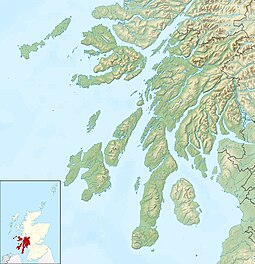Cumbrae
| Gaelic name | Cumaradh Mòr |
|---|---|
| Norse name | Kumrey |
| Meaning of name | Large island of the Cymric people |
| Location | |
|
Great Cumbrae shown within Argyll and Bute
|
|
| OS grid reference | NS169566 |
| Coordinates | 55°46′N 4°55′W / 55.77°N 4.92°W |
| Physical geography | |
| Island group | Firth of Clyde |
| Area | 1,168 hectares (4.5 sq mi) |
| Area rank | 45 |
| Highest elevation | The Glaidstane 127 metres (417 ft) |
| Administration | |
| Sovereign state | United Kingdom |
| Country | Scotland |
| Council area | North Ayrshire |
| Demographics | |
| Population | 1,376 |
| Population rank | 10 |
| Pop. density | 117.8 people/km2 |
| Largest settlement | Millport |
| References | |
Great Cumbrae (Scottish Gaelic, Cumaradh Mòr; also known as Cumbrae or the Isle of Cumbrae) is the larger of the two islands known as The Cumbraes in the lower Firth of Clyde in western Scotland. Home to the National Watersports Centre, the Cathedral of the Isles and the University Marine Biological Station, Millport, the holiday island has an 18-hole golf course which sweeps almost to the summit, and a round-island road much favoured for family cycle runs.
The island is roughly 4 kilometres (2.5 mi) long by 2 kilometres (1.2 mi) wide, rising to a height of 127 metres (417 ft) above sea level at "The Glaid Stone" - a large, naturally occurring rock perched on the highest summit on the island. There is a triangulation pillar nearby, as well as an orientation point which indicates the locations of surrounding landmarks.
In clear conditions, views extend north over the upper Clyde estuary to Ben Lomond and the Arrochar Alps. To the west, the larger islands of Bute and Arran can be seen, while on the other side of Knapdale the Paps of Jura may be visible. Looking south, Ailsa Craig is visible, around 40 miles (64 km) distant beyond Little Cumbrae. Ailsa Craig roughly marks the halfway point to Northern Ireland, which itself may be glimpsed if visibility is good. To the east, the views are not so extensive, being restricted by the higher ground of the Renfrew Hills only a few miles distant, however the town of Largs and village of Fairlie and the deep water coal terminal and power station at Hunterston can be seen.
Millport, the island's only town, is spread around a bay which makes up the entire south coast of the island. The usual island population of 1,376 as recorded by the 2011 census was a slight fall from the 2001 figure of 1,434. The population increases substantially during the summer tourist season due to the high proportion of second homes.
...
Wikipedia

